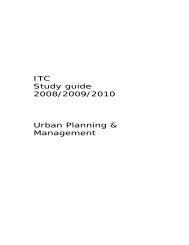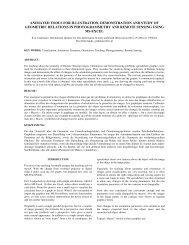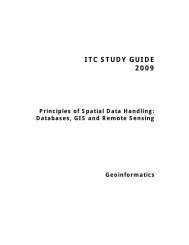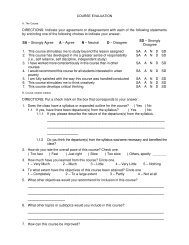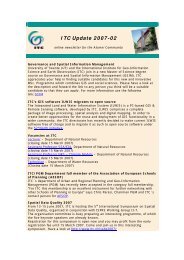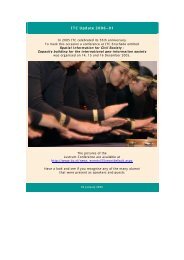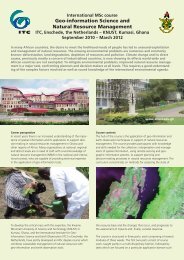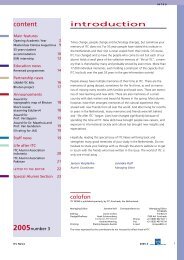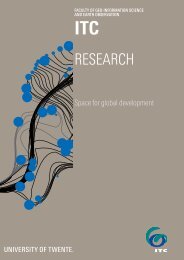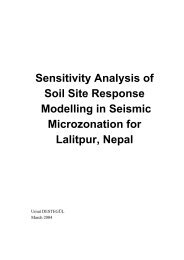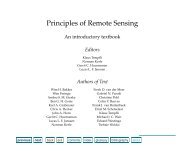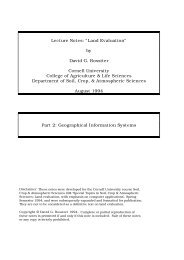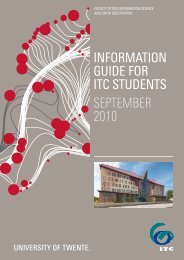Conference Report - ITC
Conference Report - ITC
Conference Report - ITC
Create successful ePaper yourself
Turn your PDF publications into a flip-book with our unique Google optimized e-Paper software.
THE AFRICAN ASSOCIATION OF REMOTE<br />
SENSING OF THE ENVIRONMENT (AARSE)<br />
AFRICAGIS 2003 <strong>Conference</strong>:<br />
"Meeting the Information Needs of NEPAD",<br />
Hôtel Méridian Président, Dakar, Senegal<br />
(3-7 November 2003)<br />
The AFRICAGIS 2003 <strong>Conference</strong> "Meeting the Information Needs of NEPAD" (3-7<br />
November 2003, see ANNEX 3) held at the Hôtel Méridian Président, Dakar, Senegal (see<br />
ANNEX 4), was organized by Centre de Suivi Ecologique (CSE), Senegal and sponsored<br />
by the Program on Environmental Information Systems in Sub-Saharan Africa (EIS Africa),<br />
the African Association of Remote Sensing of the Environment (AARSE), the African<br />
Organization for Cartography and Remote Sensing (AOCRS) supported by ESRI, FAO,<br />
Digital Globe, GEOSPACE International, MAPS geosystems, UNESCO, UN Economic<br />
Commission for Africa (ECA-SEA), UNEP, UNFPA, USAID, UNOOSA, WRI, World Bank<br />
InfoDev Program, the US State Department and the Royal Netherlands Embassy.<br />
306 participants gathered at the <strong>Conference</strong> Centre from 50 countries, with more than 60%<br />
of the participants from 32 African countries and the rest from Asia, Europe, the Middle<br />
East and North America. From outside Africa, the highest attendees were from the USA<br />
(38) and France (36).<br />
The <strong>Conference</strong> sessions brought together some of the major Geoinformation initiatives<br />
being implemented in Africa covering the oceans, land cover, environment, water<br />
resources, the underlying geodetic reference frame, and spatial data infrastructure. The<br />
objective was to provide a platform for building synergy among various on-going or<br />
proposed initiatives, all of which aim at providing information support for the<br />
implementation of NEPAD.<br />
The focus of this year's conference was very much on NEPAD. Our Senegalese partners<br />
worked very hard to place the event at a very high political level, lining up some<br />
heavyweights behind the programme. The Opening Ceremony was held under the<br />
chairmanship of the Prime Minister of Senegal, His Excellency Mr. Idrissa Seck followed<br />
by His Excellency the Minister of Environment and Sanitation Mr. Modou Diagne Fada.<br />
Their speeches indeed underscored the importance of the meeting and the significance<br />
being attached to Geoinformation technologies by the Senegalese Government. The<br />
American Ambassador followed the speech of the two Ministers to Senegal who gave an<br />
excellent reflection of the status quo in Geoinformation technology in Africa in French.<br />
Several Ambassadors were present during the opening sessions (including the Dutch<br />
Ambassador to Senegal), which were officially highlighted in the Senegalese Press and<br />
Television. The opening address was followed by the inauguration of the posters and<br />
exhibitions.
The Minister of State and General Deputy Advisor to the NEPAD Secretariat, Senegal His<br />
Excellency Mr. Abdou Aziz Sow, opened the second part of the morning. The latter made<br />
a general presentation to outline the initiatives and set the tone for the AFRICAGIS ’03<br />
<strong>Conference</strong> and exhibition. Answering the Minister’s call, the Secretary General of AARSE,<br />
Dr. Tsehaie Woldai, delivered the Draft Position Paper of AARSE on “Geoinformation for<br />
All” in support of NEPAD Strategy for Development and involvement of the communities<br />
in Africa. He sited a critical review of Geoinformation drive in Africa and the hurdles that<br />
is confronting many organizations involved in this technology in the last 30 years.<br />
Woldai’s focus was not only directed at assessing the current sustainable development<br />
problems in Africa, but also on how the benefits of Geoinformation technology such as,<br />
remote sensing, Global positioning Systems (GPS) and Geographic Information Systems<br />
(GPS), GDI as well as the improved communications technology can be harnessed to<br />
provide the fundamental basis for sustainable development in Africa. With the response of<br />
Woldai, the opening ceremony was closed and the conference sessions started in the<br />
afternoon. The sessions focussed on four sub-themes followed by Panel discussions:<br />
Sub-theme 1:<br />
Between Poverty and Prosperity - The New Development Agenda for Africa<br />
This sub-theme reviewed the main issues and challenges of development in Africa as identified by the Rio<br />
(1992) World Summit on Environment and Development, and as articulated by Africa's leaders within the<br />
framework of NEPAD. The focus was on those NEPAD components that relate to environmental assets, as<br />
well as the human and natural resources, upon which Africa could create a prosperous future. Issues<br />
regarding the development challenges and the harsh realities in Africa were treated from a policy and<br />
political perspective.<br />
Speakers were not expected to talk about Geoinformation per se. The central question addressed by this<br />
session was: What are the challenges that the development agenda present to information managers in<br />
seeking to support decision makers and various NEPAD implementation structures?<br />
Sub-theme 2:<br />
From Rio to Dakar – The Promise of Information Technology?<br />
This sub-theme revisited the first Earth Summit held in Rio de Janeiro in 1992, and re-evaluated the<br />
promising role of information and communications technologies in sustainable development. Chapter 40 of<br />
Agenda 21 (from the Summit) dealt entirely with this, and gave a lot of impetus to the development of<br />
Geoinformation and its application to environment and development issues. Since the Summit many<br />
environment-related conventions and declarations have continued to highlight the role of information. For<br />
instance the Convention to Combat Desertification, the Convention on Biological Diversity, and the United<br />
Nations Framework Convention on Climate Change, all have sections dealing with research and systematic<br />
observation, information collection, (species) identification and monitoring, information analysis and<br />
exchange, communication of information, capacity building, education and public awareness.<br />
In 2000 the United Nations General Assembly adopted a resolution (54/68) requesting the development and<br />
implementation of “the Integrated Global Observing Strategy (IGOS) so as to enable access to and use of<br />
space-based and other Earth observing data.” The Johannesburg (WSSD) Declaration (September 2002)<br />
further highlighted the important role of information, and more specifically Geoinformation technologies.<br />
There are 6 references to information and communication technologies (ICT) in the WSSD Plan of<br />
Implementation, and at least 12 specific references to key Geoinformation technologies (satellite remote<br />
sensing, geographic information systems, and global positioning systems).<br />
How much progress has been made in Africa to date? Speakers documented some of the key challenges and<br />
issues in implementing various initiatives in Africa to improve access to and the use of information against<br />
the background of progress in the wider ICT domain since Rio, and their relevance in terms of the<br />
possibilities and solutions they provide in support of sustainable development activities and decision<br />
making. Of course, being a conference for Geoinformation practitioners, special emphasis was placed on
Geoinformation and how, used within the framework of NEPAD and progressive national ICT policies, they<br />
can empower local communities and support development activities.<br />
Sub-theme 3:<br />
Geography and the Environment — Harnessing Knowledge for Action and Change<br />
The central question addressed by this sub-theme was: what opportunities do current Geoinformation<br />
technologies (remote sensing, geographic information systems, global positioning systems, locations<br />
services, etc.) present in documenting, characterizing and quantifying environmental and natural resource<br />
assets for development in Africa? Emphasis in the presentations was placed on how to leverage knowledge,<br />
and highlight the paradigm shifts and commitments necessary for the application of Geoinformation to have<br />
practical relevance to issues of environmental governance and justice, transparency in the management and<br />
exploitation of resources, poverty reduction, and sustainable development in Africa.<br />
The audience benefited from best practices in current knowledge management practices and experiences as<br />
they apply to resource allocation and utilization, as well as experiences relating to local/indigenous<br />
knowledge management practices.<br />
Sub-theme 4: Access to Information for the NEPAD: Challenges and a strategy for action<br />
This sub-theme highlighted various initiatives in response to identified needs for harmonized information<br />
on resources to support sustainable development in Africa.<br />
B. Panel Discussion<br />
The objective of the panel discussion was to tie things up:<br />
• What/where are the GAPS in the various on-going initiatives?<br />
• How can these initiatives work together to create a more effective synergy through<br />
networking, collaboration and partnerships?<br />
• What are the current and emerging capacity building needs and issues?<br />
Discussants were based on the addresses of the following keynote speakers: Craig Schwabe, Adigun Ade<br />
Abiodun and Karima Bounemra Ben-Soltane.<br />
The sessions brought together some of the major Geoinformation initiatives being<br />
implemented in Africa covering the oceans, land cover, environment, water resources, the<br />
underlying geodetic reference frame, and spatial data infrastructure. The objective was to<br />
provide a platform for building synergy among various on-going or proposed initiatives,<br />
all of which aim at providing information support for the implementation of NEPAD.<br />
The next challenge<br />
AFRICAGIS ’03 addressed itself to the challenge of being relevant to the emerging<br />
aspirations of the continent. How can the African Geoinformation community better<br />
promote and support relevant programmes to meet needs within the framework of the<br />
New Partnership for Africa’s Development (NEPAD)? How can the international<br />
community assisting Africa more effectively in this respect?<br />
The conference format in general included: opening session and 14 invited<br />
keynote addresses and 137 papers into 11 plenary and 24 technical sessions. It also<br />
included 3 Pre-conference Workshops and 32 exhibitions.<br />
Workshops:
1. Francophone Awareness Workshop on Geoinformation Tools (organizers: UNECA<br />
and EIS Africa)<br />
2. Africa Environment Information Network (organizers: UNEP and DEWA)<br />
3. The Use of Available Global Landsat Data Sets for Meeting the Information Needs<br />
of NEPAD (organized by UNOOSA)<br />
Exhibitions:<br />
Intergraph, SAMBUS (Ghana), ESRI (USA), GEOSPACE (South Africa), MAPS<br />
Geosystems (United Arab Emirates), EIS-AFRICA, UNFAO, USGS (USA), Hewlett<br />
Packard (USA), CSE (Senegal), DTGC (Senegal), UCAD (Senegal), DMG (Senegal), DGPRE<br />
(Senegal), DPN (Senegal), RCMRD (Kenya), CNTIG (Ivory Coast), CERSGIS (Ghana),<br />
African Institute of South Africa, IGB (Burkina Faso), BSA (Mauritanie), Clark Lab (USA),<br />
GIMS (South Africa), Airborne Laser Solutions (South Africa), Centre Régional<br />
AGRHYMET (Niger), ComputaMaps (South Africa), ISTAR (France), SCOT (France), <strong>ITC</strong><br />
(The Netherlands), ST2I,<br />
All submitted abstracts were presented, with few exceptions. Presentation time was short,<br />
focusing on the main points of each paper, with discussion handled at the end of the<br />
sessions. The presentations gave valuable and detailed information and were mature in<br />
many aspects. The abstract proceedings including some of the invited papers were<br />
distributed during the conference. In spite of the long conference daily duration (up to 6:30<br />
p.m. sometimes), the attendance was very high and constant to the workshop end, and<br />
discussions were lively.<br />
Two meetings (AARSE Council, EIS General Assembly) and 10 th year AFRICAGIS Award<br />
(EIS Africa and AARSE joint selection of people who have contributed to AFRICAGIS<br />
success) were conducted during the conference. Besides, a cocktail party at the beginning<br />
of the conference and an <strong>ITC</strong> alumni party (see BTOR of Mark Noort or Saskia<br />
Templeman) allowed a better social interaction and fruitful discussions. The Gala Dinner<br />
accompanied by the Senegal National Ballet at the Hôtel Méridian Président on Thursday<br />
(the 6 th of November) was by all standard sensational and was arranged by the local<br />
organizing committee and attended by the His Excellency the Minister of State responsible<br />
for the NEPAD Secretariat in Senegal.



